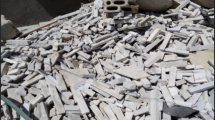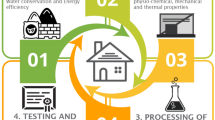Abstract
Agricultural topsoil is the most common raw material for making clay bricks in Bangladesh because of its abundance and prehistoric tradition. This practice of the bygone age is steadily pushing the environment toward the risk of fertile soil depletion. At the same time, the largest delta of this world gathers tons of sediment during the monsoon while bearing the havocs of floods due to the loss of navigability of the rivers. It propels the government to expend more on dredging. According to soil science, particle size is the only difference between clay and silt. Thus, bricks can be thought to be made from the Himalayan silt along with agricultural subsoil. However, this replacement will bring some adverse effects on the construction properties which need to be assessed. Along with the depletion of fertile topsoil, the brick sector exaggerates the environment by emitting fine particles from coal-burning during vitrification. This hazard can be lessened by incorporating internal fuel. In this work, we represent a method to produce masonry bricks by substituting the topsoil completely with riverbed silt and subsoil. The novel feature is a comparison of those silty bricks with commercial bricks available in the market to perceive the real difference in construction properties. Principally, the study presents a realistic evaluation of silt-made bricks as a building material insinuating the potential of a sustainable source of raw material for masonry bricks.





















Similar content being viewed by others
References
Porwal R (2014) Comparative study of the properties of fly ash clay bricks and clay bricks. GJESR Res Pap 1(10):51–60
Jordan L (2017) "Silo.Tips". [Accessed on 17 December, 2021]. Available at: https://silo.tips/download/sector-assessment-summary-brick-1
Hasan MB, Ali MA, Alam MS, Bhuiyan MAS (2012) Farmers’ awareness on environmental degradation nearby the brickfield areas. J Bangladesh Agril Univ 10(2):229–233
Khan HR, Rahman K, Rouf AJMA, Sattar GS, Oki Y, Adachi T (2007) Assessment of degradation of agricultural soils arising from brick burning in selected soil profiles. Int J Environ Sci Tech 4(4):471–480
Anonymous (2011) Introducing energy-efficient clean technologies in the brick sector of Bangladesh. Environment, Climate Change and Water Resources Unit, South Asia Region
United States Environmental Protection Agency, "Health and Environmental Effects of Particulate Matter (PM)". [Accessed on 17 December, 2021]. Available at: https://www.epa.gov/pm-pollution/health-and-environmental-effects-particulate-matter-pm
Mueller H, Maity S, Prajapati S, Bhatta AD, Srestha BL (2008) Vertical shaft brick kiln project: green brick making manual
Indian Standard (IS 11650:1991: 1992 (Reaffirmed 2007)) Guide for manufacture of common burnt clay building bricks by semi-mechanized process (First Revision). Bureau of Indian Standards
Premchander S, Bloesch U, Tuladhar B, Raghunandan D (2011) External review of clean building technologies for Nepal VSBK-CESEF Project 2008–2011
Ministry of Environment and Forests, Government of the People's Republic of Bangladesh (2017) National Strategy for Sustainable Brick Production in Bangladesh
Roy SD (2018) Farmlands lose topsoil for brick making. The Daily Star. https://www.thedailystar.net/country/farmlands-lose-topsoil-brick-making-1514092
Roy SD (2015) Fertility at stake as kilns ‘Buy’ topsoil from poor farmers. The Daily Star
Suryakanta, "Civilblog," 21 April 2014. [Accessed on 17 December, 2021]. Available at: https://civilblog.org/2014/04/21/field-tests-on-soil-to-determine-suitability-of-soil-for-brick-manufacturing/
Angima SD, Terry TA (2011) Best management practices for maintaining soil productivity in the Douglas-Fir region. Figure 2.2, pp 7
Mezencevova A, Yeboah NNN, Burns SE, Kahn LF, Kurtis KE (2012) Utilization of Savannah Harbor river sediment as the primary raw material in production of fired brick Andrea. J Environ Manag 113:128–136
Akter KF, Khan ZH, Hussain MS, Mazumder AR (2011) Physico-chemical characteristics of the seasonally flooded soils of bangladesh and their management implications. Dhaka Univ J Biol Sci 20(2):173–182
Hossain MM, Sattar MA (2002) Physical and chemical properties of some selected soils of Bangladesh. Online J Biol Sci 2(2):79–83
Annual Book of ASTM Standards, ASTM International, West Conshohocken, PA 2006: C 67, Standard Test Methods for Sampling and Testing Brick and Structural Clay Tile
Personal communication with Shamsunnahar Suchana (2017) Assistant Professor, Department of Civil Engineering, Bangladesh University of Engineering and Technology (BUET), Dhaka
Technical specifications for buildings by Local Government Engineering Department (LGED) and Japan International Cooperation Agency (JICA), pp. 16–18, (2005). [Accessed on 17 December, 2021]. [Available at: http://www.lged.gov.bd/UploadedDocument/UnitPublication/4/12/2005_Technical%20Specifications%20for%20Buildings.pdf]
Indian Standard (IS 1077: 1992 (Reaffirmed 2007))—Common burnt clay building bricks—specification (Fifth Revision) by Bureau of Indian Standards
European Standard (BS EN 771–1) (2003) European standard specification for clay masonry units compared to BS 3921 British standard specification for clay bricks
"Compressive /Crushing Strength of Bricks". [Accessed on 17 December, 2021]. Available at: http://www.theconstructioncivil.org/compressive-crushing-strength-of-bricks/
Acknowledgements
The author, Ms. Kaniz Fatema, is profoundly grateful for the generous support, guidance, and suggestions from the late Mr. Md. Khosru, the owner of Classic Bricks and Ceramics Company Ltd., Zirani Bazar, Savar, Dhaka without whom the research might not have been completed. The author also shows her deepest gratitude to the Civil Engineering Department (CE) and Materials & Metallurgical Department (MME) of BUET for their precious assistance.
Funding
No funding was received for this work.
Author information
Authors and Affiliations
Contributions
We confirm that the manuscript has been read and approved by all named authors. We also confirm that the order of authors listed in the manuscript has been approved by all named authors.
Corresponding author
Ethics declarations
Conflict of interest
The author declare that they have no conflict of interest.
Consent for publication
We confirm that we have given due consideration to the protection of intellectual property associated with this work and that there are no impediments to publication, including the timing of publication, concerning intellectual property. In so doing, we confirm that we have followed the regulations of our institutions concerning intellectual property.
Ethical approval
We further confirm that any aspect of the work covered in this manuscript has been conducted with the ethical approval from all related to the research.
Appendices
Appendix A: Detail calculation for the test specimens
See Tables
3,
4,
5,
6,
7,
8,
9.
Appendix B: Physical appearance of the bricks
Appendix C
Sample calculation
Sample calculation for a Type-1 clay–silt brick containing 30% silt is presented below.
Calculation for amount of raw material in brick soil mixture
Total clay mixture for green brick = 1800 gm.
Percentage of silt in clay mixture = 30 wt%
Therefore, Amount of silt in clay mixture = 1800 × 0.30 = 540 gm.
Amount of agricultural soil in clay mixture = 1800 − 540 = 1260 gm.
Amount of coal particle as internal fuel = 50 gm.
Calculation for water absorption test (wet basis)
Weight of saturated surface-dried brick, SSD = 1493 gm.
Weight of oven-dried brick, OD = 1240 gm.
Therefore, water absorption = \(\frac{SSD-OD}{SSD}\times 100= \frac{1493-1240}{1493}\times 100=16.95 wt\%\)
Calculation for compressive strength test
Length of fired brick after oven-dry = 113.35 mm.
Width of fired brick after oven-dry = 107.47 mm.
Load = 115 kN.
Therefore, Area of fired brick after oven-dry = 113.35 × 107.47 = 12,181.72 mm2.
Actual load = 1.026 × load − 11.59.
= 1.026 × 115 − 11.59.
= 106.40 kN.
= 106,400 N.
Now, Compressive strength, CS = \(\frac{\mathrm{Actual load}}{\mathrm{Area}}\)
\(=8.7 \frac{N}{{\mathrm{mm}}^{2}}\) or MPa.
For Type-3 bricks, 5% of the clay mixture, i.e., 90 g cement and ground sand has been used, respectively.
Rights and permissions
About this article
Cite this article
Fatema, K., Hossain, I. Utilization of riverbed silt and subsoil of Gopalganj for masonry bricks incorporating internal fuel and comparison of their construction properties with commercial bricks. Innov. Infrastruct. Solut. 7, 141 (2022). https://doi.org/10.1007/s41062-022-00745-8
Received:
Accepted:
Published:
DOI: https://doi.org/10.1007/s41062-022-00745-8




